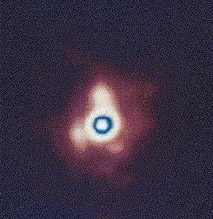Procyon

The Procyon System is located about 11.5 light-years (ly) from our Sun. Procyon A, or Alpha Canis Minoris A, is the brightest and most centrally located naked-eye star (07:39:18.12+05:13:29.98, ICRS 2000.0) of Constellation Canis Minor (the Smaller Dog). Procyon is also the upper left member of the "Winter Triangle" of first magnitude stars, whose other components are Sirius (Alpha Canis Minoris) at lower left and Betegeuse (Alpha Orionis) at right center (see also wide-field image from Astronomy Picture of the Day).
Alpha Canis Minoris A has a close companion star B that is separated "on average" by only about 16 times the distance from the Earth to the Sun -- 14.9 astronomical units (AUs) of an orbital semi-major axis -- which is roughly the distance between Uranus and our Sun. Alpha Minoris B, the companion star, is a white dwarf, stellar remnant and is so dim that it cannot be perceived with the naked eye. After analyzing irregularities in the proper motion of Procyon which were first detected in 1840, Arthur Julius Georg Friedrich von Auswers (1838-1915) deduced the presence of this faint but massive companion and published a computed period of 40 years in 1861. However, Procyon B was not detected visually until 1896 by John M. Schaeberle (1853-1924) with the 36-inch refractor at Lick Observatory. There is a third optical companion C.(Solstation)
 |
Procyon at a resolution of 0.2 arc-seconds.ion C.USAF AMOS, Maui, Hawaii . There is clear evidence of multiple sources. |
Alpha Canis Minoris A, the Little Dog Star, is the eighth brightest star in the night sky as well as the brightest star in its constellation. Unlike the Sun, it is a white-yellow main sequence dwarf star of spectral and luminosity type F5 V-IV . This relatively large star has about 1.5 times the solar mass (Girard et al, 2000) and about 1.4 to 2.3 times its diameter (0.00510 to 0.00550", according to the Yale Bright Star Catalogue, 1991 5th Revised Edition notes entry for HR 2943). Compared to the Sun, moreover, Procyon A is hotter and about 7.5 times brighter. Procyon radiates somewhat more in ultraviolet wavelengths than Sol, and, not surprisingly, the European Space Agency has used ultraviolet spectral flux distribution data to determine stellar effective temperatures and surface gravities, including those of Procyon.(Solstation)
Procyon Appears to be a relatively young star with only around 1.7 +/- 0.3 billion years (Kenneth Croswell, 2005; and Eggenburger et al, 2005). However, being so much bigger and hotter Sol, the star will exhaust its core hydrogen within even the 4.6 billion years of Sol's current age and turn into a red giant before puffing away its outer layers to reveal a remnant core as a white dwarf. Indeed, Procyon A is unusually bright for its spectral type and so may be becoming a subgiant star that is beginning to evolve off the main sequence, as it begins to fuse the increasing amounts of helium "ash" mixed with hydrogen at its core.(Solstation)
Sources:
- http://www.solstation.com/stars/procyon2.htm
- http://en.wikipedia.org/wiki/Gl_15_Star_System
- Lippincott, S. L., "Parallax and orbital motion of the 2 nearby long-period visual binaries Groombridge 34 and ADS 9090", 1972, Astronomical Journal, 77, 165.
Nearby Stars
Star Concepts
| HyperPhysics***** Astrophysics | R Nave |